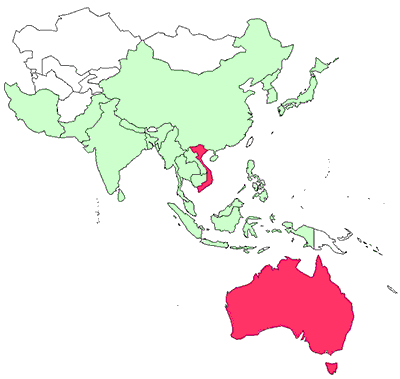Diseases of crustaceans
Viral diseases—Spherical baculovirosis
CLICK ON IMAGE TO ENLARGE

Source: DV Lightner
Signs of diseases
Important: animals with disease may show one or more of the signs below, but disease may still be present in the absence of any signs.
Disease signs at the farm level
- lethargy
Clinical signs of disease in an infected animal
- emaciation
- secondary gill and surface fouling by ectoparasites
Gross signs of disease in an infected animal
- white hepatopancreas (digestive gland) and midgut
Disease agent
The causative agent is a Penaeus monodon-type baculovirus.
Host range
Crustaceans known to be susceptible to the virus:
banana prawn* (Penaeus merguiensis)
brown tiger prawn* (Penaeus esculentus)
caramote prawn* (Penaeus kerathurus)
eastern king prawn* (Penaeus plebejus)
giant tiger prawn* (Penaeus monodon) - most susceptible
grooved tiger prawn* (Penaeus semisulcatus)
red endeavour prawn* (Metapenaeus ensis)
redtail prawn* (Penaeus pencillatis)
* naturally susceptible (other species have been shown to be experimentally susceptible)
Presence in Asia–Pacific

Spherical baculovirus has been officially reported from Australia and Vietnam. However, various strains of Penaeus monodon-type baculovirus are considered enzootic in wild penaeid stocks throughout the Asia–Pacific region.
Epidemiology
- Transmission is horizontal, direct from the water column or through cannibalism. It is believed, but not proven, that transmission can also be vertical from broodstock to offspring.
- Other species of prawns exposed to the virus may act as carriers.
- Up to 90% mortality occurs in postlarval hatchery prawns, especially at high densities.
- With good culture practices, mortalities from even severe spherical baculovirus infections in cultured populations can be negligible.
Differential diagnosis
The differential diagnostic table and the list of similar diseases appearing at the bottom of each disease page refer only to the diseases covered by this field guide. Gross signs observed might well be representative of a wider range of diseases not included here. Therefore, these diagnostic aids should not be read as a guide to a definitive diagnosis, but rather as a tool to help identify the listed diseases that most closely account for the gross signs.
Similar diseases
Baculoviral midgut gland necrosis, tetrahedral baculovirosis
Sample collection
Because of uncertainty in differentiating diseases using only gross signs, and because some aquatic animal disease agents might pose a risk to humans, you should not try to collect samples unless you have been trained. Instead, you should phone your national hotline number and report your observations. If samples have to be collected, the agency taking the call will advise you on what you need to do. Local or district fisheries/veterinary authorities could advise you on sampling.
Emergency disease hotline
For your national emergency disease hotline number, see Whom to contact if you suspect a disease.
Further reading
http://www.oie.int/aac/eng/cards/en_diseasecard.htm
The currently accepted procedures for a conclusive diagnosis of spherical baculovirosis are summarised at http://www.oie.int/eng/normes/fmanual/A_00052.htm
These hyperlinks were correct and functioning at the time of publication.

